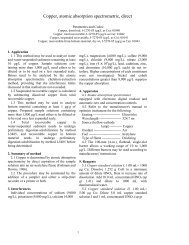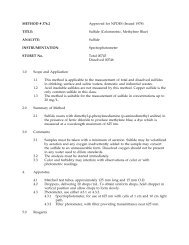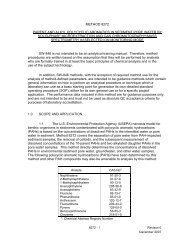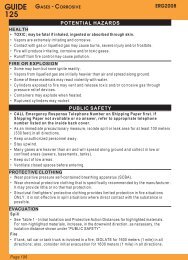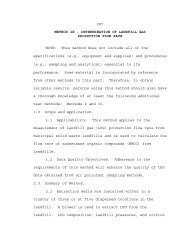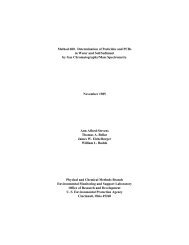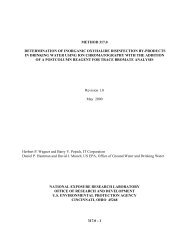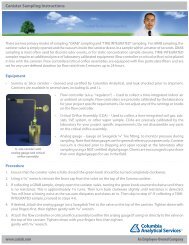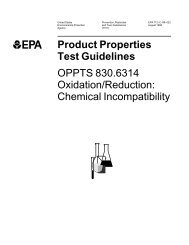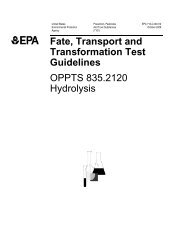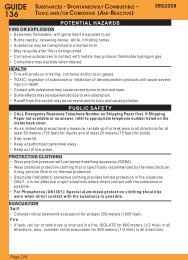View Actual EPA Method 8081A (PDF File)
View Actual EPA Method 8081A (PDF File)
View Actual EPA Method 8081A (PDF File)
You also want an ePaper? Increase the reach of your titles
YUMPU automatically turns print PDFs into web optimized ePapers that Google loves.
8000, Sec. 8.0 for information on evaluating surrogate data and developing and updating surrogatelimits.8.6 It is recommended that the laboratory adopt additional quality assurance practices for usewith this method. The specific practices that are most productive depend upon the needs of thelaboratory and the nature of the samples. Whenever possible, the laboratory should analyzestandard reference materials and participate in relevant performance evaluation studies.9.0 METHOD PERFORMANCE9.1 The method detection limit (MDL) is defined in Chapter One. A laboratory should developits own matrix-specific MDLs using the guidance found in Chapter One.9.2 The chromatographic separations in this method have been tested in a single laboratoryby using clean hexane and liquid and solid waste extracts that were spiked with the test compoundsat three concentrations. Single-operator precision, overall precision, and method accuracy werefound to be related to the concentration of the compound and the type of matrix.9.3 This method has been applied in a variety of commercial laboratories for environmentaland waste matrices. Performance data were obtained for a limited number of target analytes spikedinto sewage sludge and dichloroethene stillbottoms at high concentrations. These data are providedin Tables 9 and 10.9.4 The accuracy and precision obtainable with this method depend on the sample matrix,sample preparation technique, optional cleanup techniques, and calibration procedures used.9.5 Tables 9 and 10 contain precision and recovery data generated for sewage sludge anddichloroethane stillbottoms. Table 11 contains recovery data for a clay soil, taken from Reference10. The spiking concentration was for the clay soil was 500 µg/kg. The spiking solution was mixedinto the soil and then immediately transferred to the extraction device and immersed in the extractionsolvent. The spiked sample was then extracted by <strong>Method</strong> 3541 (Automated Soxhlet). The datarepresent a single determination. Analysis was by capillary column gas chromatography/electroncapture detector following <strong>Method</strong> 8081 for the organochlorine pesticides.10.0 REFERENCES1. Lopez-Avila, V., Baldin, E., Benedicto, J, Milanes, J., Beckert. W.F., "Application of Open-Tubular Columns to SW-846 GC <strong>Method</strong>s", final report to the U.S. Environmental ProtectionAgency on Contract 68-03-3511; Mid-Pacific Environmental Laboratory, Mountain <strong>View</strong>, CA,1990.2. Development and Application of Test Procedures for Specific Organic Toxic Substances inWastewaters. Category 10 - Pesticides and PCB Report for the U.S. Environmental ProtectionAgency on Contract 68-03-2606.3. Goerlitz, D.F., Law, L.M., "Removal of Elemental Sulfur Interferences from Sediment Extractsfor Pesticide Analysis", Bull. Environ. Contam. Toxicol., 1971, 6, 9.4. Jensen, S., Renberg, L., Reutergardth, L., "Residue Analysis of Sediment and Sewage Sludgefor Organochlorines in the Presence of Elemental Sulfur", Anal. Chem., 1977, 49, 316-318.CD-ROM <strong>8081A</strong> - 23 Revision 1December 1996



